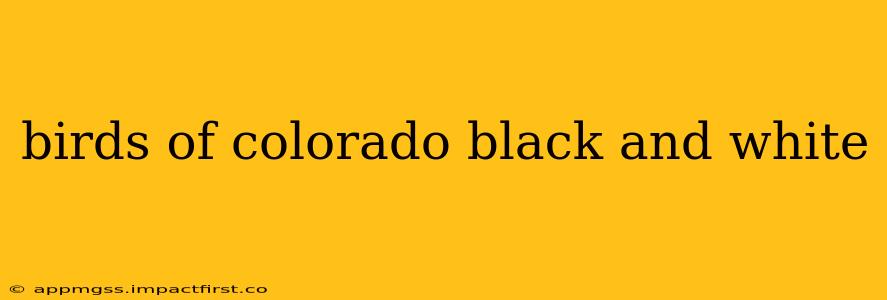Colorado boasts a vibrant avian population, with hundreds of species gracing its diverse landscapes. Identifying birds can be a rewarding hobby, and while vibrant colors certainly help, focusing on black and white markings provides a valuable alternative, especially for those learning or in challenging light conditions. This guide will explore some of Colorado's most common birds, highlighting their key black and white features to aid in identification.
What are some common black and white birds in Colorado?
Many Colorado birds exhibit striking black and white patterns. Some of the most frequently sighted include the Magpie, the Black-capped Chickadee, the Steller's Jay, the Loggerhead Shrike, and various species of flycatchers. The exact pattern and proportion of black and white vary considerably between species, making careful observation crucial.
How can I tell the difference between similar black and white birds in Colorado?
Distinguishing between similar-looking birds requires close attention to detail. Size, shape, beak structure, and subtle variations in plumage patterns all play critical roles. For instance, while both the Magpie and the Steller's Jay are largely black and white, the Magpie is significantly larger, with a longer tail and a distinctive, long, graduated tail. The Steller's Jay has a more pronounced crest. Comparing field guides with detailed illustrations and descriptions alongside your observations is invaluable.
Are there any black and white birds in Colorado that are migratory?
Yes, several black and white Colorado birds are migratory. For example, some flycatcher species, like the Black-and-white Warbler, only spend part of the year in Colorado, migrating to other areas for breeding or wintering. Understanding the migratory patterns of various species helps to narrow down the possibilities when attempting identification. Their presence will be seasonal.
What resources can I use to identify black and white birds in Colorado?
Several excellent resources are available to aid bird identification in Colorado. Field guides specific to the region are essential, offering detailed descriptions, illustrations, and range maps. Online resources such as the Audubon Bird Guide and eBird provide valuable information, including photographs, songs, and distribution maps. Joining local birding clubs or participating in organized bird walks can provide hands-on learning opportunities and expert guidance.
What are some tips for identifying birds in black and white?
- Focus on shape and silhouette: Before considering specific markings, take note of the overall body shape and the bird’s posture. Is it slender and long-tailed, or stockier with a short tail?
- Pay attention to beak shape and size: The beak's shape often reflects the bird's diet. A strong, hooked beak indicates a predator, while a slender, pointed beak suggests an insectivore.
- Note the pattern and distribution of black and white markings: Is the black concentrated on the wings, head, or body? Are the white markings in patches or stripes?
- Consider the habitat: The location where you observed the bird can provide crucial clues. Certain species prefer specific habitats, such as forests, grasslands, or wetlands.
- Use binoculars: Binoculars are essential for close-up observation of smaller details, allowing you to appreciate subtle variations in plumage.
Conclusion: Embracing the Monochromatic World of Colorado Birds
While color is often the first thing we notice about birds, mastering black and white identification significantly broadens your birding abilities. By focusing on shape, size, beak structure, and the intricate patterns of black and white markings, you can confidently identify a wider range of Colorado birds. Remember to use a variety of resources, practice your observation skills, and enjoy the rewarding process of unraveling the mysteries of Colorado's avian world, one black and white feather at a time.
